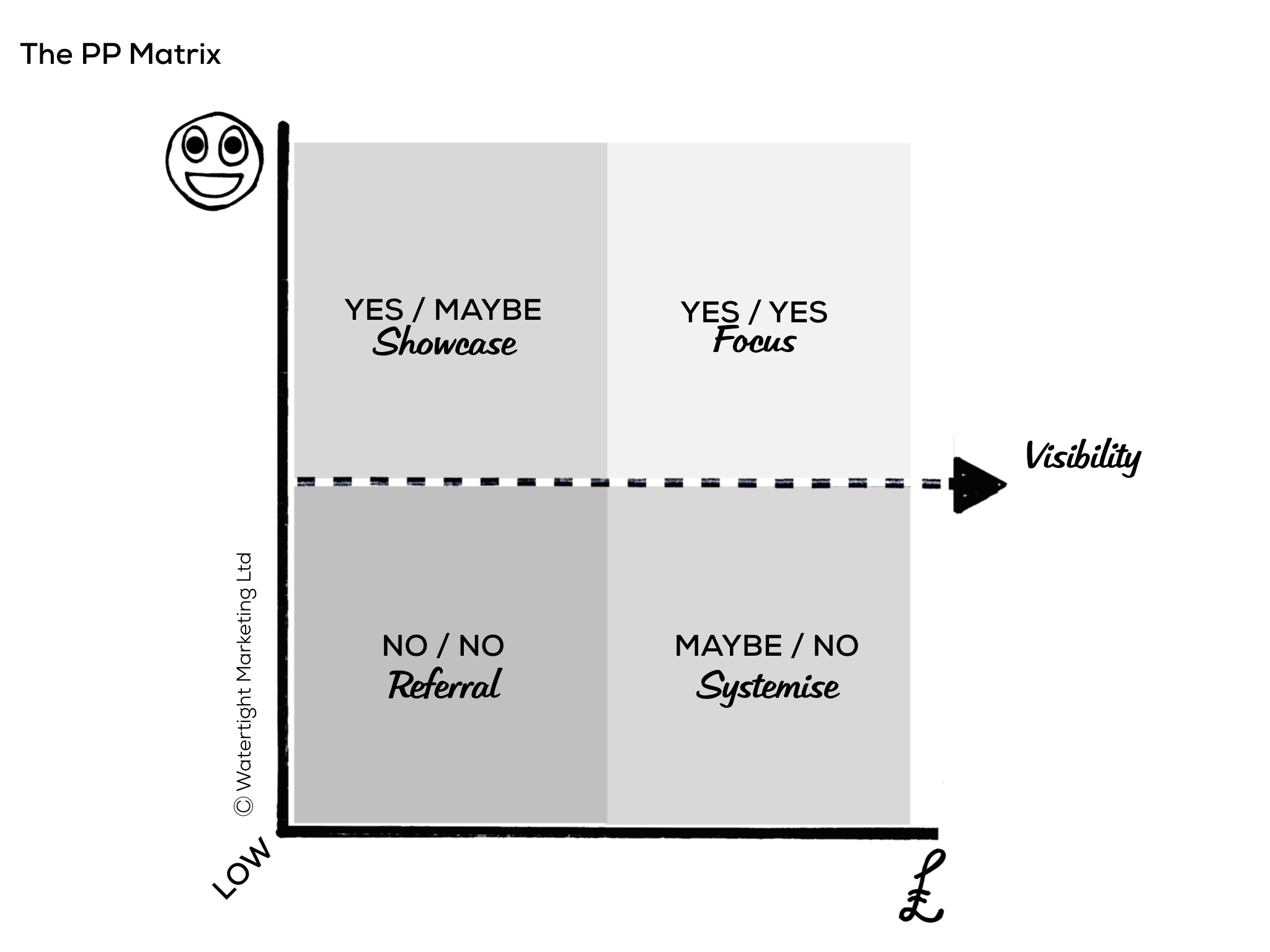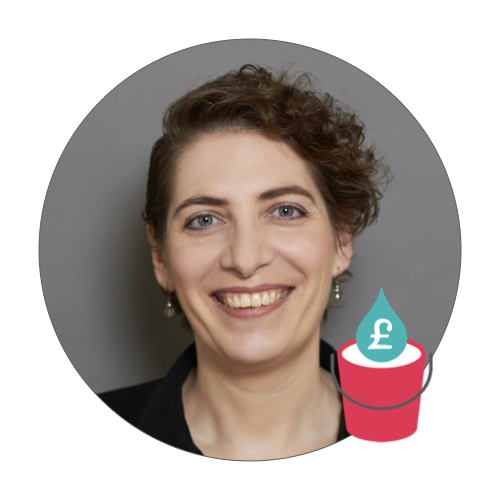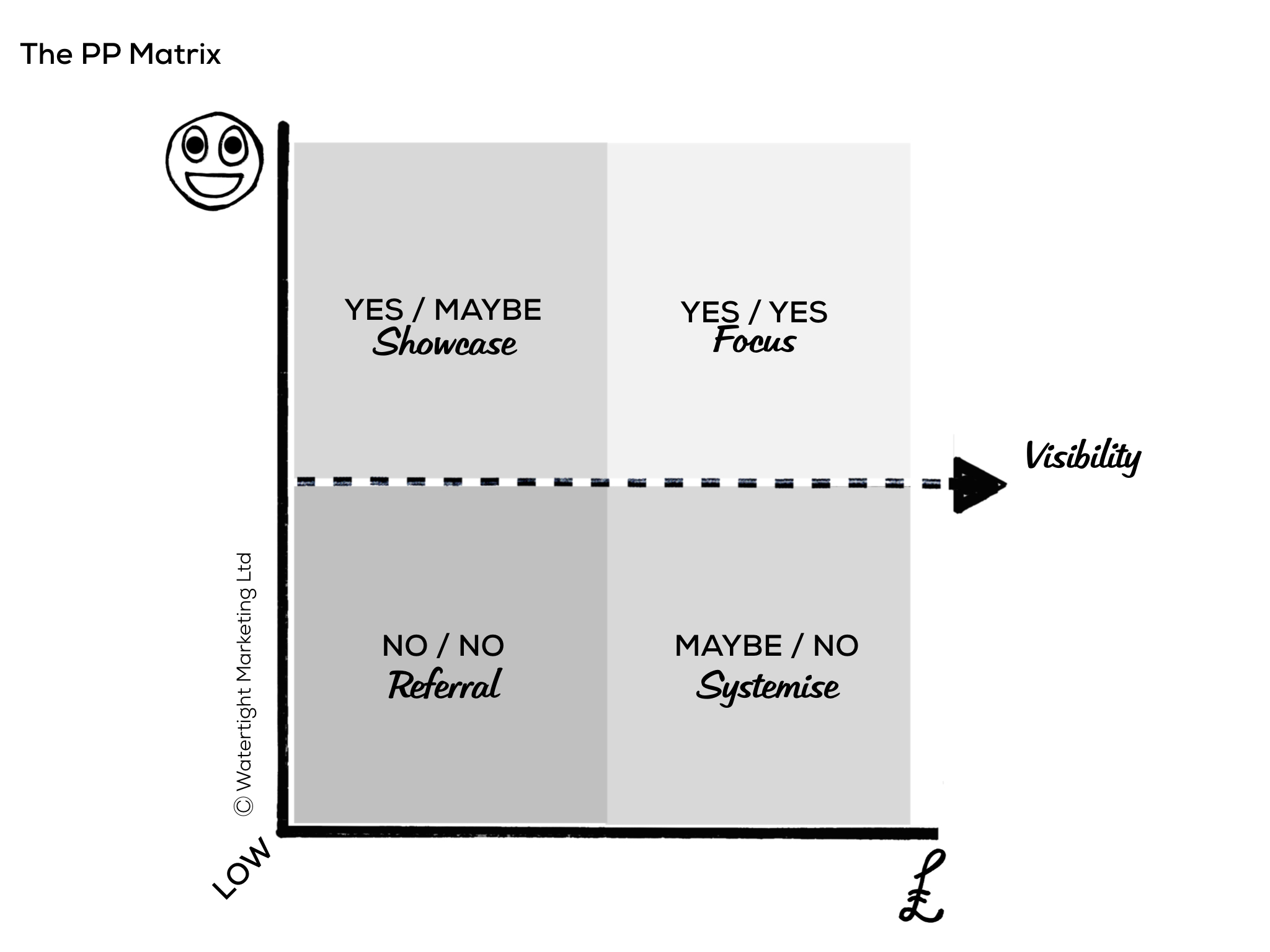Prefer to listen than to read?
This post is also available over on our PodBlog
Reading Time: 2 Minutes
For many of our clients, it’s not necessarily that they need more clients, it’s that they need more of the right clients. And, in many more cases, once this has been clearly defined and a strategy put in place to reflect it, they end up getting more anyway. In this article, Bryony Thomas details how to use the Purpose Profit Matrix to be selective about your clients.
Like many marketers, we will start a client engagement by asking organisations to walk us through their client mix. Slightly unusually, we segment these not only by things like vertical markets or demographics, but by whether or not the company really wants to be working with them.
Truly sustainable growth is only possible when you can sustain the organisation both financially and energetically. If you’re serving customers that really get you or your team down, the only turnover that’s likely to increase is the number of employees walking out the door. In an owner-managed businesses, this is even more obvious and you can tangibly see having too many of the wrong kind of clients putting a serious strain on your personal health and wellbeing. (This is captured in Chapter 2 of Watertight Marketing, where I describe the Foundation Leaks).
To determine what’s right for your organisation, in the long term, we use the PP Matrix. We map your products, services, and the characteristics of your potential clients onto this grid.
Using The Purpose Profit Matrix to be selective about your clients
Does your heart sing or sink?
You start by characterising the Purpose of your organisation. If you’ve not already done so, grab a copy of Start with Why by Simon Sinek to help you with this.
As shorthand, we ask people to characterise the work they do that makes their heart sing or sink? When a client name flashes across the phone screen, are you excited to take the call, or do you start feeling anxious? Clearly, you want more of the ones that light you up. With more of these in your business, you and your team will be happier, and do your best work. What is this for you?
Is this commercially viable?
The next thing to define, is what comes together to make the work financially sustainable by understanding what drives your Profit. Of course, one of the factors in this is how much people are willing to pay. But, you also need to look at the cost to serve.
For example, getting the most from our Masterplan programme means logging on, watching videos and chatting in online forums. If you’re not a tech-savvy person, it becomes harder for us to provide value and service calls tend to increase. What is this for you?
Four strategies to maximise your business health & wealth
When you’ve defined these things, you get to four business strategies to put in place for sustainable growth:
- Focus: Your Yes/Yes work is where you would want to be spending a good 80% of your time.
- Showcase: Your Yes/Maybe work is work you take on, in agreement for some publicity value, for example a charity project that you can case study. We recommend about 10% of time here.
- Systemise: Your Maybe/No is work that you take on if you don’t have to spend your emotional energy to deliver it. This can often be achieved by creating a self-serve or online version of your offer. We recommend about 10% of time here.
- Refer Out: Your No/No work is the work that you elegantly decline. Ideally, you can continue to generate an income from this by referring it on to an organisation that is the right fit. (See: How to say no to the wrong kind of work)
Staying above the line of visibility

Once you have this mapped out, one of the most powerful things to do, is to commit to only ever talking about work that’s above the line of visibility. That is, only talk loudly about the work that makes your heart sing. This can sometimes mean that you create a different brand for the Systemised offerings. It most cases, it means taking a few case studies off your website. It’s really important that you don’t talk too much about the work that you don’t actually want.
Powerful other ways to use this tool…
It’s a deceptively simple little tool. We use this with clients in so many ways, for example:
- Setting out the four strategic models above and the business models to support them.
- As a tool for building out qualification criteria for inbound enquiries.
- As a strategic customer management tool to continually review and consider ongoing relationships with clients.
- As a content planning tool, to ensure all public-facing materials are above the line of visibility.
- As a role design tool to ensure that employees are getting a good mix of client exposure.
- As a recruitment tool to ensure that potential recruits are aligned with the audience you have in mind.
Taking time to understand and apply the PP Matrix will quickly get you to see where the business is sapping your energy, and how to focus on what is truly sustainable – energetically and financially.
© Watertight Marketing Ltd

Bryony Thomas
Author & Founder, Watertight Marketing
Bryony Thomas is the creator of the multi-award winning Watertight Marketing methodology, captured in her best-selling book of the same name. She is one of the UK's foremost marketing thinkers, featured by the likes of Forbes, The Guardian, Business Insider and many more, and in-demand speaker for business conferences, in-house sales days and high-level Board strategy days.



